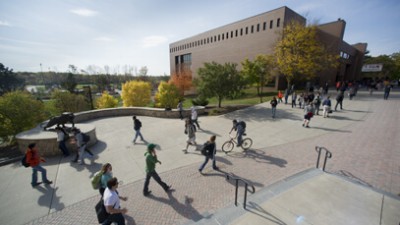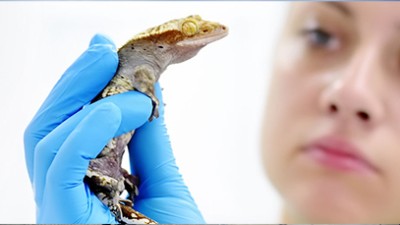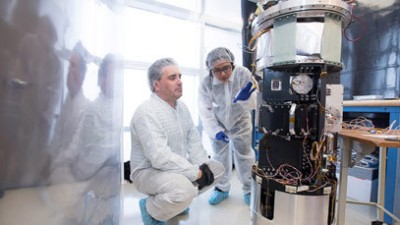News
-
November 24, 2020
![illustration of people in bubbles to show the potential exposure to COVID-19.]()
The odds of contracting COVID-19 at Thanksgiving
WHEC-TV talks to Nathan Cahill, associate professor in the School of Mathematical Sciences and director of the mathematical modeling Ph.D. program, about potential exposure to COVID-19.
-
November 18, 2020
![side-by-side images of a 15th-century manuscript, one showing regular text and the other showing text that had been erased.]()
RIT students discover hidden 15th-century text on medieval manuscripts
RIT students discovered lost text on 15th-century manuscript leaves using an imaging system they developed as freshmen. By using ultraviolet-fluorescence imaging, the students revealed that a manuscript leaf held in RIT’s Cary Graphic Arts Collection was actually a palimpsest, a manuscript on parchment with multiple layers of writing.
-
November 5, 2020
![Color map of the curvature on the large black hole horizon generated by the near merging small black hole.]()
New black hole merger simulations could help power next-gen gravitational wave detectors
Scientists have developed new simulations of black holes with widely varying masses merging that could help power the next generation of gravitational wave detectors. RIT Professor Carlos Lousto and Research Associate James Healy from RIT’s School of Mathematical Sciences outline these record-breaking simulations in a new Physical Review Letters paper.
-
October 29, 2020
![chart showing masses of blck holes in in the 50 gravitational wave events detected to date.]()
LIGO and Virgo announce 39 new gravitational wave discoveries during first half of third observing run
The LIGO Scientific Collaboration and Virgo Collaboration released a catalog of results from the first half of its third observing run (O3a), and scientists have detected more than three times as many gravitational waves than the first two runs combined. Several researchers from RIT’s Center for Computational Relativity and Gravitation were heavily involved in analyzing the gravitational waves and understanding their significance.
-
October 21, 2020
![College of Science Professor Emeritus Linda Barton.]()
Professor Emeritus Linda Barton honored for laboratory instruction by American Physical Society
Professor Emeritus Linda Barton is the 2021 recipient of the Jonathan F. Reichert and Barbara Wolff-Reichert Award for Excellence in Advanced Laboratory Instruction.
-
October 14, 2020
![researchers in masks working in a lab.]()
L3Harris becomes industry partner for RIT’s Future Photon Initiative
RIT’s Future Photon Initiative (FPI) and L3Harris have entered into a new industry partnership to develop quantum technologies. The partners will begin developing next steps for experiments and analysis focused on quantum information processing for communication, sensing, and computing.
-
September 14, 2020
![aerial view of buildings on RIT campus.]()
RIT again ranked among the best universities in the nation by U.S. News
RIT has again been recognized as one of the best national universities by U.S. News & World Report, which also cited the university as among the most innovative, with strong undergraduate research opportunities and a highly regarded cooperative learning program.
-
September 9, 2020
![artist's concept illustrating a hierarchical scheme for merging black holes.]()
RIT scientists contribute to the first discovery of an intermediate-mass black hole
The LIGO Scientific Collaboration and the Virgo Collaboration recently announced the discovery of GW190521, the most massive gravitational wave binary observed to date, and Rochester Institute of Technology scientists played an important role in identifying and analyzing the event.
-
August 5, 2020
![detector chip carriers and socket.]()
RIT student Justin Gallagher helps lead NASA-funded project to build single photon detectors
An RIT student is on a mission to help build detectors that could identify individual photons from distant, inhabitable planets. Justin Gallagher, a fifth-year student from Rochester, N.Y., pursuing his BS in physics and MS in astrophysical sciences and technology, is serving as project manager for a nearly $1 million grant funded by NASA to create a single photon sensing and number resolving detector for NASA missions.
-
August 3, 2020
![professor looking at laptop.]()
RIT faculty gearing up to apply spring learnings to fall classes
The unexpected transition to remote learning during the spring semester challenged faculty across RIT to experiment, create, and deploy new methods of instruction to ensure student success. As the university gears up for in-person and online classes—or a combination of both—faculty members are applying a wide range of lessons learned from the spring to keep academic momentum moving forward in the fall.
-
July 31, 2020
![professor sitting at his desk in the 1980s.]()
Douglas Merrill retires from RIT after 40 years, establishes student fund
Douglas Merrill, who inspired countless students during his 40-year tenure in the College of Science and the College of Health Sciences and Technology, has retired. He developed the Premedical Advisory Program and created the Center for Bioscience Education and Technology. And he retires with numerous honors recognizing his outstanding teaching and commitment to diversity and inclusion.
-
June 23, 2020
![screenshot of program that searches math formulas.]()
RIT researchers create easy-to-use math-aware search interface
Researchers at RIT have developed MathDeck, an online search interface that allows anyone to easily create, edit and lookup sophisticated math formulas on the computer. Created by an interdisciplinary team of more than a dozen faculty and students, MathDeck aims to make math notation interactive and easily shareable, and it's is free and open to the public.
















